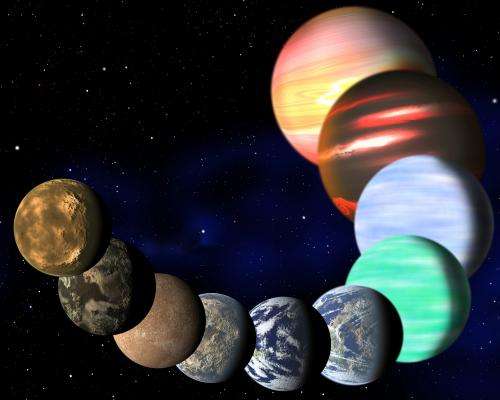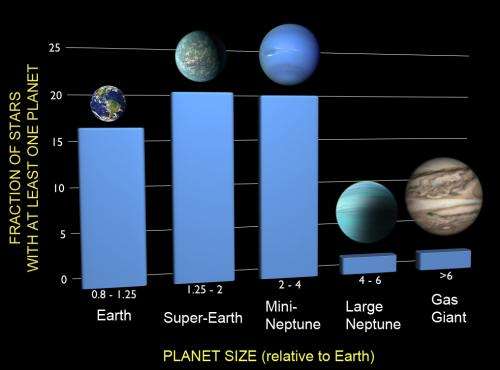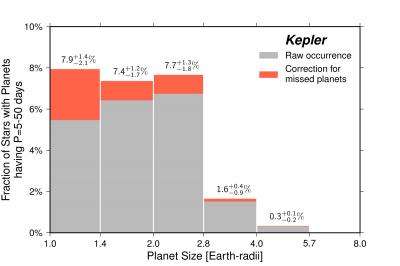Study: At least one in six stars has an Earth-sized planet

(Phys.org)—The quest for a twin Earth is heating up. Using NASA's Kepler spacecraft, astronomers are beginning to find Earth-sized planets orbiting distant stars. A new analysis of Kepler data shows that about 17 percent of stars have an Earth-sized planet in an orbit closer than Mercury. Since the Milky Way has about 100 billion stars, there are at least 17 billion Earth-sized worlds out there.
Francois Fressin, of the Harvard-Smithsonian Center for Astrophysics (CfA), presented the analysis today in a press conference at a meeting of the American Astronomical Society in Long Beach, Calif. A paper detailing the research has been accepted for publication in The Astrophysical Journal.
Kepler detects planetary candidates using the transit method, watching for a planet to cross its star and create a mini-eclipse that dims the star slightly. The first 16 months of the survey identified about 2,400 candidates. Astronomers then asked, how many of those signals are real, and how many planets did Kepler miss?
By simulating the Kepler survey, Fressin and his colleagues were able to correct both the impurity and the incompleteness of this list of candidates to recover the true occurrence of planets orbiting other stars, down to the size of Earth.

"There is a list of astrophysical configurations that can mimic planet signals, but altogether, they can only account for one-tenth of the huge number of Kepler candidates. All the other signals are bona-fide planets," says Fressin.
Most sun-like stars have planets
Altogether, the researchers found that 50 percent of stars have a planet of Earth-size or larger in a close orbit. By adding larger planets, which have been detected in wider orbits up to the orbital distance of the Earth, this number reaches 70 percent.
Extrapolating from Kepler's currently ongoing observations and results from other detection techniques, it looks like practically all Sun-like stars have planets.
The team then grouped planets into five different sizes. They found that 17 percent of stars have a planet 0.8 - 1.25 times the size of Earth in an orbit of 85 days or less. About one-fourth of stars have a super-Earth (1.25 - 2 times the size of Earth) in an orbit of 150 days or less. (Larger planets can be detected at greater distances more easily.) The same fraction of stars has a mini-Neptune (2 - 4 times Earth) in orbits up to 250 days long.
Larger planets are much less common. Only about 3 percent of stars have a large Neptune (4 - 6 times Earth), and only 5 percent of stars have a gas giant (6 - 22 times Earth) in an orbit of 400 days or less.

Smaller planets aren't picky
The researchers also asked whether certain sizes of planets are more or less common around certain types of stars. They found that for every planet size except gas giants, the type of star doesn't matter. Neptunes are found just as frequently around red dwarfs as they are around sun-like stars. The same is true for smaller worlds. This contradicts previous findings.
"Earths and super-Earths aren't picky. We're finding them in all kinds of neighborhoods," says co-author Guillermo Torres of the CfA.
Planets closer to their stars are easier to find because they transit more frequently. As more data are gathered, planets in larger orbits will come to light. In particular, Kepler's extended mission should allow it to spot Earth-sized planets at greater distances, including Earth-like orbits in the habitable zone.
Journal information: Astrophysical Journal
Provided by Harvard-Smithsonian Center for Astrophysics



















